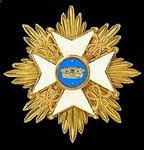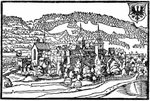Here are the flags of Prussian IR26:
Created 1715 from units that were first raised as far back as 1659. Garrisoned in Berlin from 1716 with six other regiments. Recruited Pomerania and the Wendish Slavs.
A trusted and reliable regiment that was with the King's Army from 1756 until 1760, it was initially involved in the forced capitulation of the Saxon army at Pirna. At Prague 6th May 1757 it was involved in the attack through the gap in the Austrian lines south of Kej, with heavy artillery support, and it lost about 1/6th casualties. General Hautcharmoy died leading the attack. Lucky to avoid Kolin, it was at Rossbach in November and then Breslau. At Leuthen on December 5th both battalions were in the advance guard under Wedell and attacked the Sagschutzer Kiefernberg. Prinz Moritz of Dessau told the King: "Your Majesty may safely entrust your crown and sceptre to the keeping of this regiment. If it ever runs before the enemy, I know it must be time to make myself scarce as well." (Barsewisch quoted Duffy Army of Frederick the Great, henceforth AFG). At the beginning of the swing to the left of the oblique approach, the King directed the regiment: "You must not advance too strongly, so the army can follow. You have the enemy before you and the whole army behind you!" In the attack on Leuthen, Prinz Moritz called out: "Honour enough, go back for the second line!" Our boys answered: "We would be dog food (if we did); give us cartridges [Patronen]!" and beat off a cavalry attack. (All these quotations are from Barsewisch's memoir*.) The regiment lost 10 officers and 454 men. On December 8th it received 15 Pour le Merite medals (says Duffy AFG; 14 say Dorn and Engelmann, Infantry of Frederick the Great), a record only exceeded by Alt-Braunschweig at Rossbach.
The regiment was before Olmutz in June to July 1758 then in Silesia, Dresden in September and then at Hochkirch on October 14th. The regiment was placed north-west of the village and the King stationed himself behind the regiment for some time during the unexpected Austrian attack, which was more like a Napoleonic envelopment than the usual attack by lines. Eventually the regiment was reduced to 150 men with 3 flags, who fought their way out. Subaltern Barsewisch records getting 30 men together with 3 flags and personally escaping by throwing away his (new) sash and hat to distract pursuing Austrian cavalrymen. He met Frederick and apologised for not having sash or hat as he feared being criticised for being improperly dressed! As Christopher Duffy says (AFG again), Frederick was a hard man to please. Frederick distributed the 3 rescued flags amongst his surviving troops. In 1759 the remnant of the regiment was with the King in camp at Schmottseiffen, then at the siege of Dresden July 10th to 22nd 1760 and then at the battle of Liegnitz on August 14th, where about 1/8th of the regiment were casualties. It spearheaded the attack of Butke's brigade at Torgau, until Zieten's attack saved the day. In 1761 it was in Saxony. On October 29th 1762 it stormed the heights of St Michaelis at the battle of Freiberg as part of the right wing under Seydlitz.
Christopher Duffy says the regiment went unrewarded after the Seven Years War, despite its fine fighting record. He also points out that the brandenbourgs (the lace round the buttonholes) of the officers' coats were copied in the collar patches of German generals of the two world wars of the 20th century.
(* One of the best sources for the history of the regiment in the SYW is E F von Barsewisch's memoir Meine Kriegs-Erlebnisse während des siebenjähriges Krieges 1757-1763, Berlin 1863, which is recommended by Christopher Duffy, AFG. I managed to find a copy online and downloaded it, but the gothic script and my very poor German made it difficult for me to puzzle my way through. I did translate a little, with the help of my wife who did German at school; I wish I had done German as well as French, Spanish and Latin but it clashed on the timetable with geography! It would be good if someone would do a translation; so many interesting memoirs of the period are rather inaccessible to an English-speaking and reading audience. My French is OK but that is not so much use for the Prussian army - odd that Frederick was happier speaking and writing in French, of course... ;-))
And here is a musketeer's uniform in 1756:



















